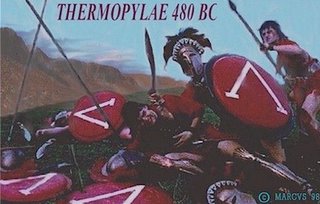Constricting.
This is coolbert:
Both the 300 Spartans at Thermopylae 2500 years ago and the Afrikaners at Blood River in the 1800's employed a defensive technique [constricting terrain] that served them both well.
When faced with overwhelming numbers, both defenders sought, found, and used with great skill terrain superior for the defense. Terrain that allowed the attacker to attack from only in one direction and only in limited numbers [the constricting terrain limits the numbers of troops that can pass at any given time].
In the case of the Spartans, when faced with delaying an army of Persians reputed to be the largest army ever fielded prior to that point, a narrow "pass" between the sea and a precipitous mountainous rise was selected as the place to do battle.
In the case of the Spartans, when faced with delaying an army of Persians reputed to be the largest army ever fielded prior to that point, a narrow "pass" between the sea and a precipitous mountainous rise was selected as the place to do battle.
This "pass" [the "Hot Gates" Thermopalae] was actually a ten yard wide flat stretch of land between the water and the mountainous rise [this constricting terrain has long silted over. It is now about a mile from the mountainous area to the sea].
There was no way around this "pass" and the Persian army was compelled to use it.
It was here that Leonidas and his Spartans made their defense.
The Spartans, well armed, trained, experienced, led by their King, and determined to fight to the last man, gave a good account of themselves, using the advantage of the terrain to defeat numerous attempts by the Persian army to force passage. The superior numbers of the Persians could not come into play here. Defeated in the end by overwhelming numbers, the Spartans did delay the Persians long enough to allow Greek forces to mobilize and organize a successful defense of their homeland.

The Afrikaners at Blood River in the 1800's also made successful use of constricting terrain in their defensive battle against overwhelming numbers of Zulu warriors [10,000 Zulus versus 500 Afrikaners].

The Afrikaners at Blood River in the 1800's also made successful use of constricting terrain in their defensive battle against overwhelming numbers of Zulu warriors [10,000 Zulus versus 500 Afrikaners].
Blood River is another example of the strategic defensive. The 500 Afrikaners invaded Zulu territory and found superior terrain that would constrict the Zulu army.
The Zulus would be forced to attack from one direction only and then only limited numbers all at once.
Setting up their defensive position on this superior terrain, the Afrikaners were able to defeat the much larger Zulu force [it is estimated that the casualties were 4000 dead on the Zulu side, a cut hand on the side of the Afrikaners!!!].
Of course, the Afrikaners were armed with muzzle loading rifles and were opposed by warriors armed with stabbing spears, oxhide shields, and knokberries [clubs with a knot on the end]. But, it should also be noted that in the 1870's, a Zulu army of 30,000 men was able to overpower and totally annihilate a British force of 1500 men!!! So it was not only weaponry alone.

Some interesting tactics were employed by the Afrikaners at Blood River. The Afrikaner riflemen held their fire until the charging Zulu warriors were within six feet before opening fire.

Some interesting tactics were employed by the Afrikaners at Blood River. The Afrikaner riflemen held their fire until the charging Zulu warriors were within six feet before opening fire.
This created a wall of human dead that the subsequent charges of Zulus would have to climb over before they could get close to the defenders.
Among the defenders, only about 100 men actually were firing the muzzle loading rifles, the remainder loading and reloading discharged weapons. Each of the 500 men among the defenders had come prepared with about four rifles each, a lot of thought having been given evidently to the defense the Afrikaners had in mind from the start.
coolbert.
coolbert.

<< Home